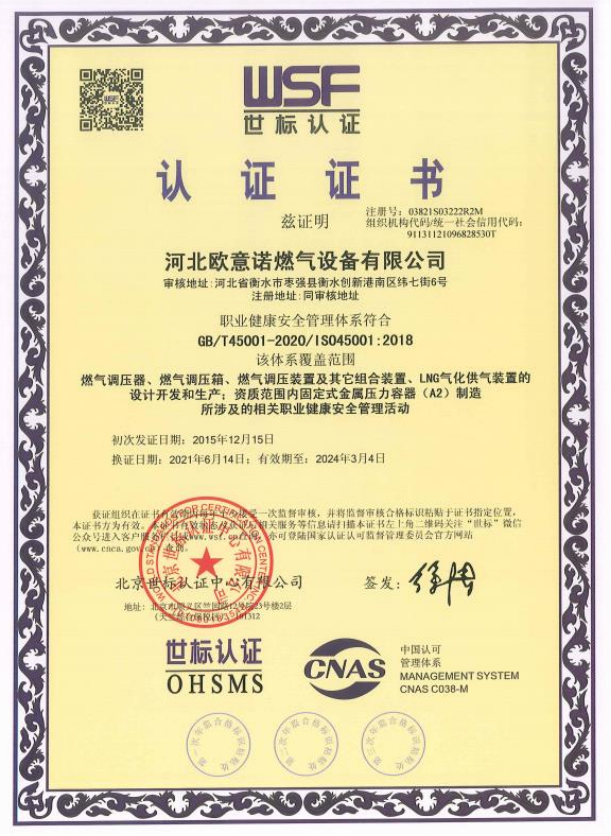
Nov . 30, 2024 07:04
Back to list
Equipment for Pressure Relief and Management Solutions
Understanding Pressure Relief Equipment Importance and Applications
Pressure relief equipment plays a critical role in ensuring the safety and integrity of various industrial processes. These devices are designed to prevent excessive pressure buildup in systems, which could lead to catastrophic failures, explosions, or other hazardous situations. Whether in chemical processing plants, oil and gas facilities, or manufacturing settings, the importance of effective pressure relief mechanisms cannot be overstated.
What is Pressure Relief Equipment?
Pressure relief equipment is a collective term for various devices that help manage and control pressure within a system. This includes pressure relief valves (PRVs), rupture discs, and vacuum relief valves. Each of these devices serves a specific purpose in maintaining safe operating conditions.
1. Pressure Relief Valves (PRVs) PRVs are mechanical devices that automatically release pressure when it exceeds a predetermined level. They are designed to close once the pressure drops back to a safe level, ensuring that the system remains stable. PRVs are often used in steam, gas, and liquid applications, playing a vital role in protecting pipelines and vessels from damage.
2. Rupture Discs Unlike PRVs, rupture discs are engineered to fail at a specific pressure. They are typically made of fragile materials that rupture when pressure builds to a certain threshold. This instant release of pressure helps prevent more catastrophic failures. Rupture discs are often used in conjunction with PRVs for added safety.
3. Vacuum Relief Valves These valves are essential in systems where a vacuum needs to be maintained. They prevent the formation of a vacuum that could potentially collapse storage tanks or other vessels. When the pressure inside the system drops below atmospheric pressure, the vacuum relief valve opens to allow air in, equalizing the pressure.
The Importance of Pressure Relief Equipment
The significance of pressure relief equipment extends beyond mere compliance with safety regulations. Here are some key reasons why these devices are essential
.
- Regulatory Compliance Many industries are subject to rigorous safety regulations. Proper installation and maintenance of pressure relief devices ensure compliance with national and international safety standards, thereby avoiding legal repercussions.
معدات تخفيف الضغط

- System Integrity Overpressure can cause serious damage to pipelines, tanks, and other system components. By managing pressure effectively, relief equipment helps maintain the structural integrity of these systems, reducing the risk of costly repairs and downtime.
- Operational Efficiency By preventing pressure fluctuations, relief devices contribute to smoother operation of industrial processes. This can lead to improved efficiency, productivity, and ultimately, profitability.
Best Practices for Pressure Relief Equipment
To maximize the effectiveness of pressure relief equipment, several best practices should be followed
1. Regular Maintenance Routine inspections and maintenance are crucial for ensuring that pressure relief devices function correctly. Regular testing can identify potential issues before they lead to failures.
2. Correct Sizing Pressure relief devices must be appropriately sized for the specific application. An undersized device may fail to relieve pressure adequately, while an oversized one may not operate effectively.
3. Proper Installation Following industry guidelines for the installation of pressure relief equipment is essential. Improper installation can lead to malfunctions or inefficiencies.
4. Training Staff should be adequately trained on the operation and importance of pressure relief equipment. This includes understanding when and how to perform inspections and maintenance.
Conclusion
In summary, pressure relief equipment is vital for maintaining the safety and integrity of industrial systems. Through the effective use of pressure relief valves, rupture discs, and vacuum relief valves, organizations can prevent dangerous overpressure situations, comply with regulations, and promote operational efficiency. Understanding and implementing best practices for pressure relief equipment can significantly reduce risks and enhance safety across various industries. As technology advances, the development of more sophisticated pressure management devices will likely continue, further improving safety standards and operational efficiency in industrial applications.
Latest news
-
Safety Valve Spring-Loaded Design Overpressure ProtectionNewsJul.25,2025
-
Precision Voltage Regulator AC5 Accuracy Grade PerformanceNewsJul.25,2025
-
Natural Gas Pressure Regulating Skid Industrial Pipeline ApplicationsNewsJul.25,2025
-
Natural Gas Filter Stainless Steel Mesh Element DesignNewsJul.25,2025
-
Gas Pressure Regulator Valve Direct-Acting Spring-Loaded DesignNewsJul.25,2025
-
Decompression Equipment Multi-Stage Heat Exchange System DesignNewsJul.25,2025

